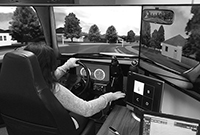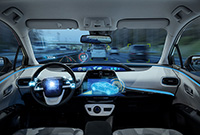 Researchers: Philart Jeon, PI
Researchers: Philart Jeon, PI
Sponsor: Hyundai Motor Company
Amount of Support: $130, 236
Duration of Support: 1 year
Purpose and Target: To investigate effectiveness of an in-vehicle gesture control system and culture-specific sound preference, Michigan Tech will design a prototype of in-air gesture system and auditory displays and conduct successive experiments using a medium fidelity driving simulator.
Technical Background: Touchscreens in vehicles have increased in popularity in recent years. Touchscreens provide many benefits over traditional analog controls like buttons and knobs. They also introduce new problems. Touchscreen use requires relatively high amounts of visual-attentional resources because they are visual displays. Driving is also a visually demanding task. Competition between driving and touchscreen use for visual-attentional resources has been shown to increase unsafe driving behaviors and crash risk
- Horrey, and C. Wickens, “In-vehicle glance duration: distributions, tails, and model of crash risk” Transportation Research Record: Journal of the Transportation Research Board, vol. 2018, pp. 22-28, 2007.
- Green, “Crashes induced by driver information systems and what can be done to reduce them,” In Sae Conf. Proc. SAE; 1999, 2000.
- Hatfield, W. Wyatt, and J. Shea, “Effects of auditory feedback on movement time in a Fitts task,” Journal of Motor Behavior, vol. 42, no. 5, pp. 289-293, 2010.
 Researchers:
Researchers: 


 Guy Hembroff, associate professor and director of the Medical Informatics graduate program (CC/CyberS), attended the three-day workshop, “Teaching With Impact – Innovating Curriculum With Entrepreneurial Mindset,” in Milwaukee, Wisc., this July.
Guy Hembroff, associate professor and director of the Medical Informatics graduate program (CC/CyberS), attended the three-day workshop, “Teaching With Impact – Innovating Curriculum With Entrepreneurial Mindset,” in Milwaukee, Wisc., this July.